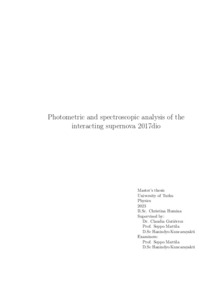Photometric and spectroscopic analysis of the interacting supernova 2017dio
Humina, Christina (2023-10-09)
Photometric and spectroscopic analysis of the interacting supernova 2017dio
Humina, Christina
(09.10.2023)
Julkaisu on tekijänoikeussäännösten alainen. Teosta voi lukea ja tulostaa henkilökohtaista käyttöä varten. Käyttö kaupallisiin tarkoituksiin on kielletty.
avoin
Julkaisun pysyvä osoite on:
https://urn.fi/URN:NBN:fi-fe20231016140370
https://urn.fi/URN:NBN:fi-fe20231016140370
Tiivistelmä
Core-collapse supernovae (CCSNe) are the bright explosions of massive stars. During the explosion heavy elements are produced by nuclear burning. One of these products is 56Ni that radioactively decays into 56Co. The explosion energy and the produced 56Ni and its product 56Co are what powers the light curves of classical supernovae (SNe).
Stripped envelope (SE) SNe have lost their hydrogen (H) and in some cases, helium (He) envelopes through mass loss at some point in their lives. These SE SNe are known to produce SNe of types IIb (weak H), Ib (He-rich), Ic (He-poor), and Ic-BL (He-poor broad lines). Type IIn SNe, on the other hand, are SNe that interact with circumstellar medium (CSM) around the progenitor. The CSM is thought to be caused by the progenitor’s mass loss. The mechanism of the mass loss for these can happen in a variety of ways. All stars have mass loss through stellar winds, but in some cases, it is not enough to produce interaction that would produce a type IIn. The mass loss can also happen because of pair instability pulsations, eruptions, or binary effects. The mass loss can be studied by analysing the observational properties of a SN and understanding the mass loss might shed light on what kind of progenitor produced the SN.
In this thesis, photometric and spectroscopic data of SN 2017dio are analysed. The photometric data are used to study the explosion epoch, light curves, and color curves of SN 2017dio and it is compared with four other SNe. The spectroscopic data are used to verify the classification of SN 2017dio, to study the spectral evolution, and to discuss the possible CSM properties and progenitor scenario. The findings indicate that SN 2017dio is a SN of type Ic-BL interacting with H-rich CSM. Both spectroscopic and photometric analysis support the theory of the CSM not being close to the explosion site and the calculated mass loss rate 0.04M⊙/year indicates that the progenitor must have experienced massive mass loss periods in the decade before its explosion.
Stripped envelope (SE) SNe have lost their hydrogen (H) and in some cases, helium (He) envelopes through mass loss at some point in their lives. These SE SNe are known to produce SNe of types IIb (weak H), Ib (He-rich), Ic (He-poor), and Ic-BL (He-poor broad lines). Type IIn SNe, on the other hand, are SNe that interact with circumstellar medium (CSM) around the progenitor. The CSM is thought to be caused by the progenitor’s mass loss. The mechanism of the mass loss for these can happen in a variety of ways. All stars have mass loss through stellar winds, but in some cases, it is not enough to produce interaction that would produce a type IIn. The mass loss can also happen because of pair instability pulsations, eruptions, or binary effects. The mass loss can be studied by analysing the observational properties of a SN and understanding the mass loss might shed light on what kind of progenitor produced the SN.
In this thesis, photometric and spectroscopic data of SN 2017dio are analysed. The photometric data are used to study the explosion epoch, light curves, and color curves of SN 2017dio and it is compared with four other SNe. The spectroscopic data are used to verify the classification of SN 2017dio, to study the spectral evolution, and to discuss the possible CSM properties and progenitor scenario. The findings indicate that SN 2017dio is a SN of type Ic-BL interacting with H-rich CSM. Both spectroscopic and photometric analysis support the theory of the CSM not being close to the explosion site and the calculated mass loss rate 0.04M⊙/year indicates that the progenitor must have experienced massive mass loss periods in the decade before its explosion.
